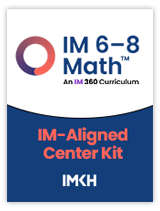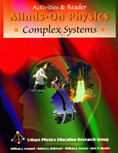Search Listing Name

product:
IM v.360: Grade 6 Lesson Only Card Deck Kit
To help educators save time, IM v.360-aligned center kits provide all the printed resources to imp

product:
MINDS ON PHYSICS: COMPLEX SYSTEMS, ACTIVITIES & READER
Not a traditional textbook - the Minds On Physics Student Activities Book is comprised of two parts: Activities and the Reader. The Activities form an integrated set of thoughtful engagements for students, and the Reader organizes and summarizes the ideas of the physics content and is meant to be read after students have engaged in associated activities.<
product:
Project M3: Level 3-4: Unraveling The Mystery of The MoLi Stone: Exploring Place Value and Numeration Student Mathematician's Journal + 1 Year License
The Student Mathematician’s Journal allows students to explore simulated or real-life problems and help them to think, write, and read like mathematicians. It encourages students to reflect on what they have learned in each lesson, think deeply about mathematics, and communicate in writing on worksheets.
In this unit, students explore our numeration system in depth and discover a stone wit
product:
The Aurora Chronicles
On June 7, 2114, the Earth Survey Ship Aurora disappeared near Jupiter, leaving no trace behind as to its destination, nor as to the fate of its crew. On July 20, 2134, the ESS Aurora returned, carrying with it all the horrors of the void, but also with the promise of information gathered from its ghastly inter-dimensional and time travels. It falls to the people of a secret United Earth agency, the OAR, to negotiate for what the ghostly vessel offers, and the Aurora always demands a sacrifice in return.
product:
OpenSciEd Unit 8.2: Sound Waves Spanish Student Edition
OpenSciEd Middle School science program addresses all middle school NGSS standards. This comprehensive science curriculum empowers students to question, design, investigate, and solve the world around them.
- Phenomenon Based - Centered around exploring phenomena or solving problems
- Driven by Student Questions - Storyline based on students’ questions and ideas
- Grounded in Evidence - Incremental building and revision of ideas based on evidence
- Collaborative - class and teacher figure
product:
Project M2 Level K Unit 2: Exploring Shapes in Space: Geometry with the Frogonauts Student Mathematician Journal
The Student Mathematician’s Journal presents simulated or real-life problems that encourage students to think, write, and read like mathematicians. They are asked to reflect on what they have learned and communicate in writing on worksheets.
In this unit, students help prepare Fonzie Frog for his trip to the Lily Pad Space Station where he will join Freeda, a Frogonaut in space. Students are involve
product:
Ancient Egypt: Gift of the Nile Student Guide
Ancient Egypt: Gift of the Nile Student Guide New!
Grades 2-3
This unit is designed around the idea that human civilizations develop and sustain themselves as a collection of interdependent systems. The civilization of ancient Egypt forms the central content of the unit, with exploration of systems of agriculture, economics, language, and leadership in this anci
